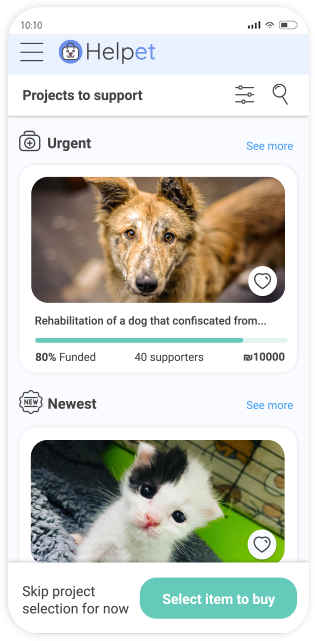
Mobile App
?What is Helpet
Helpet is a crowdfunding app based on supporting projects that benefit animal welfare. Users can donate new and used items or volunteer their professional services, and the revenues generated are transferred via supporters to maintain the chosen project(s).
My role:
Research, Branding, UX & UI Design, Prototyping
Background
Nowadays, there are about two million street cats in Israel. The state does not provide high-quality public veterinarian services and substantial neutering for wandering cats. This situation leads to the growth, in numbers, of street cats. Also, there are street dogs in the same situation but on a smaller scale. The street animals live poorly in hard conditions such as starvation, sickness with environmental hazards.
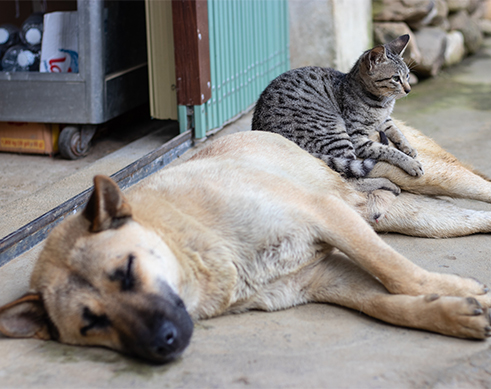
Understanding the Problem
Due to the lack of structured governmental response to provide animal aid, animal lovers and private activists respond to the challenge to support street animals. Typically, these animals require extensive care and so the activists either take on the costs themselves or try to raise funds through social media via their personal profiles of animal-focused groups.
This fundraising process is unstructured, frustrating and time-consuming, which can result in insufficient funding for animal care.
I propose a user-friendly platform that is fully dedicated to help animal activists fund their project(s) in exchange for goods or services.
Competitive Research
The product is a combination of crowdfunding and e-commerce. I have done research through several applications that address the different topics to find more information regarding general structures and behavioral patterns, features and overall appearance. To the best of my knowledge, applications that combine both features do not exist as of yet.
Indirect Competition
Although the e-commerce area is an integral part of Helpet, other applications do not compete directly with it. Helpet is a social application, unlike other e-commerce that their main priority is sales.
Direct Competition
My initial idea came from getting familiar with an animal association whose main activity has been on Facebook. The association has been collecting used items from the public and selling them. The funds received have been distributed by that society to different activists at their discretion.
Therefore, I thought of taking the general idea of the association and upgrading it into something more efficient, digital and on a larger scale.
Insights
Reward for Support
Helpet competitors offer rewards that are specific to the projects that were chosen to be supported. In contrast, a supporter in Helpet will have the option to fund different projects in parallel, while being able to choose from the app’s items variety.
Projects Area
In crowdfunding applications that I have researched, it is possible to start a project in any subject, not necessarily social, which gives a great advantage because it addresses a greater audience. Due to the complexity of the combination of crowdfunding and e-commerce, I have chosen to focus on projects for animal welfare at this stage.
The Environment
Helpet supports the recycling of clothing and general items which contributes to maintaining a green, safe and healthy environment.
Transfer of Funds
This app is a great platform for projects in need of funds, in a short period of time. Funds are transferred directly and immediately to animal treatment even before the end of the project.
There are two main and essential behavioral patterns that I’ve learned from the research and I would like to use the Helpet app:
Filters
Displays selected items from different categories on the main screen and a constant filter button in the top menu, which by clicking on it can focus the search.
Display of Products and Projects
Display of products and projects – present items on the main screen with big pictures and most important details: Price of items and the sum of the collected funds in projects.
Focusing On Goal
The goal of Helpet is to efficiently bridge between three major users: the donors, the supporters and the private animal activists, in order to facilitate animal welfare projects, while each and every part benefits from the process.
User Types
The application’s target audience is animal lovers in general and dogs and cats in particular.
There are three types of users and every user has its own needs:
The supporter generates the revenue from the items and transfers them to the treatment of the animals. This study case focuses on the supporter’s side.
The donor offers new/used items for sale or professional services, made for the good of society.
The private animal activist initially opens the project(s) for funding and finally receives the funds and conducts their project(s)
User Persona - Supporter
Jenny is a student, pursuing her bachelor’s degree in computer science and works part-time. In the past, Jenny volunteered at an animal shelter facility, where she adopted a cat and a dog. Jenny cares about the environment and prefers to recycle. She maintains a healthy diet and lost 10Kg, making her old clothes too large, hanging over her waist.
:Goals
- Helping animals
- Saving money
- Purchasing new clothes
:Pain Points
- A student without spare money
- Lack of time to volunteer at animal shelters
- A change to the closet’s inventory is impossible because of the lack of funds

Jenny Miler
25 old – Student
At lunch breaks, Jenny browses on Facebook and encounters an urgent post. One of her friends, Natalie, has been seeking funds for treating a kitten that was run over by a car. Jenny is emotional – she wants to help but does not have any spare money to donate.
How Helpet enters the picture
Jenny shows the post to Rachel, her friend from university, and shares her concerns. Rachel tells Jenny that she saw a new application that can fit her needs and possibly solve the problem. In that app, Jenny can choose animal projects she cares about, and fund them through buying used clothes at low fares. The money generated goes directly to the project and both sides benefit.

Challenges & Solutions
Home Page
Challenge: My main challenge was to choose which topic to emphasize: the animal project or the services/sales. In that equation, it was important that choosing one venue would not neglect the other, since both are connected and hold the whole app together.
Solution: After great deliberation, the conclusion was that the main purpose of this app is supporting and funding animal projects. However, on the Home Page there will still be an option to move between the two tabs; for the users who prefer to start with services/items.
User Flow
Challenge: A large volume of selections of salable items and the long process of choosing projects and items may be long and exhausting for the users.
Solution: The app escorts the user through the process, making it easier on him by performing interim summaries – at every end of a stage and at the end of the overall transaction. It is possible to add a project to a favorites list and to return to it later when ending the support process. Also, the app provides various search engines and filters that can be easily used and applied through each step of the process.
Refund On Items
Challenge: The return of defective items or dissatisfaction situations can cause potential problems, since the money from the sales was already transferred to the animal care projects.
Solution: To avoid misunderstandings, there is a disclaimer that there will be no refund on returns. In case the item is defective or does not match the description, there will be an option to ‘report item’. A complaint that is justified, will receive credit in the app.
Trustworthiness
Challenge: Since the app relies on private people that do not know each other, it is built on mutual trust between the three user types. This situation may carry a potential risk.
Solution: The app stresses the importance of displaying as much information about the project and the activist as possible so that the buyer will be sure that the money goes to the assigned purpose. Each project has an activist’s bio, Facebook page, contact info, project summary and previous or running projects (if there are any).
User Flow
Usability Testing
After creating the main flow in the app and UX characterization, I wanted to check it on a number of users for feedback. As a result, two main structures have changed before moving on to the user interface step.
Initially, the main screen was divided into two tabs: the project’s main page and the item’s main page. A home page structured this way felt confusing and complicated for the users.
Therefore, I decided to change the structure of the main page in a way that it would be more accessible. There are no longer two tabs, leaving only projects to fund – the main focus of the app. Occasionally, the user would prefer to choose an item first, then there will be an option to skip the initial project selection screen. In those instances, supporters will have the option to purchase an item without selecting a specific project and the funds will transfer automatically to the most urgent project in need. In addition, supporters will have the option to transfer fundings without receiving a reward.
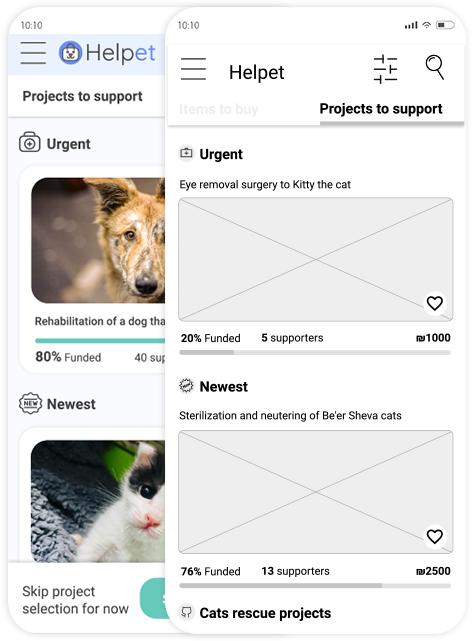
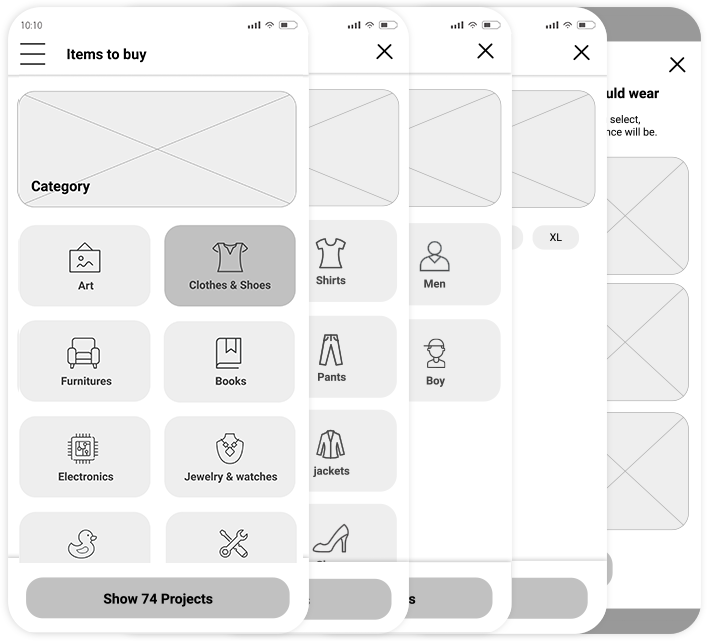
The filtering processes were shortened and as a result, became more efficient:
Originally, the app had five stages of filters that made the user flow long. In order to shorten the experience, I have removed two stages in the initial filtering stage. These filters could be changed and reused on the Results page.
Typography
Roboto Bold, Regular
Output
Design
The app design will be clean and minimalistic although unique and will focus on large pictures of the items and projects. The UX and UI of the app will be consistent and intuitive for users. The same structure for both subjects: e-commerce and crowdfunding, with adjustments relevant for each subject.
UI Colors
The Blue and Green spectrum are primary colors used in the app for their association with trust.
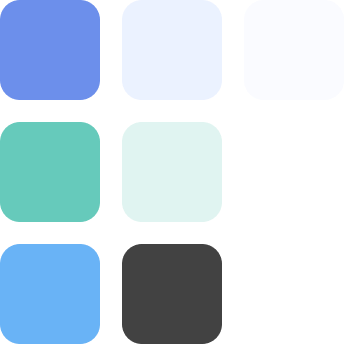

Home Page
The Home page is the projects page. On this page, projects are presented by subjects and there is an ability to perform a more precise exploration by searching or by filtering topics.
At the bottom of the page, there is an option to ‘skip project selection for now’ and start with item selection instead.
Supporting What You Want
You can click on the ‘filter’ icon and make the project selection more specific. An important feature during filtering is the ability to search for specific activists. For example, there is an option to select for a familiar activist that the user wants to support their projects in particular.
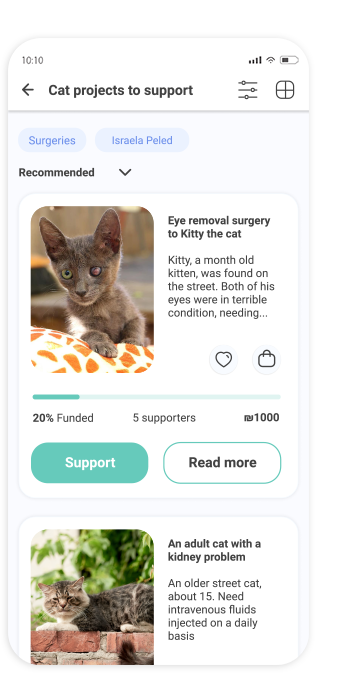
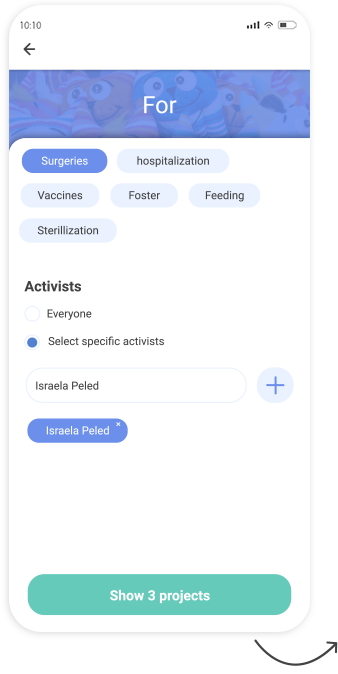
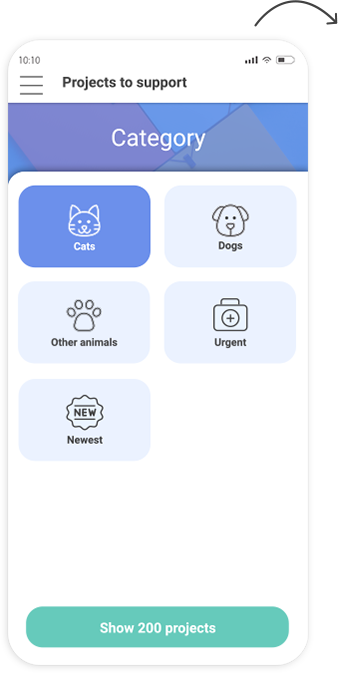
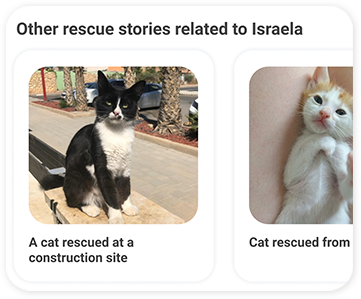



Projects Page
Each project has an activist’s bio, Facebook page, contact info, project summary and previous or running projects.
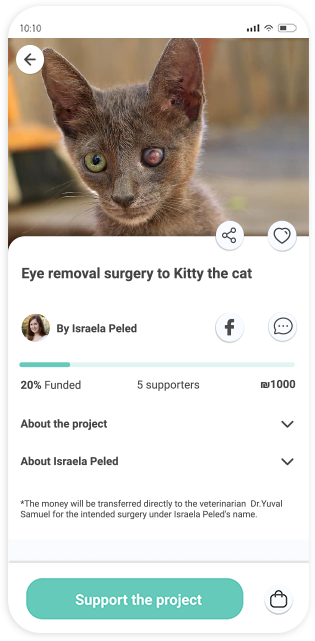

Projects Cart
Summary of all the projects that were selected, by the user, for funds transaction.
Main Items Page
In this page, items are presented by subjects and there is an ability to perform a more precise exploration by searching or by filtering topics.
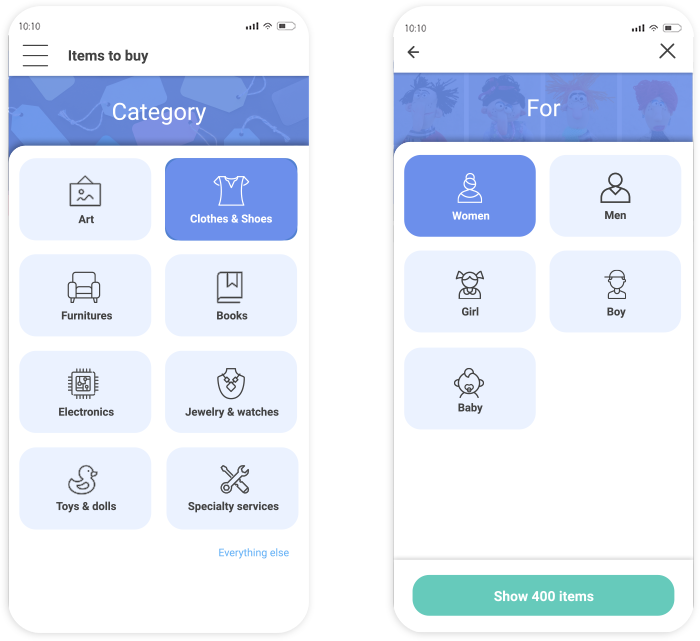
Filter Items
The initial filtering process consists of basic category selection in order to get the desired results as quickly as possible.
Deeper Learning, Better Results
An extra step during the initial filtering process is to choose items that match the user’s taste. This action is done by selecting from a list. The item selection helps in receiving consumer insights resulting in more precise picks for the user.
This step can be skipped.
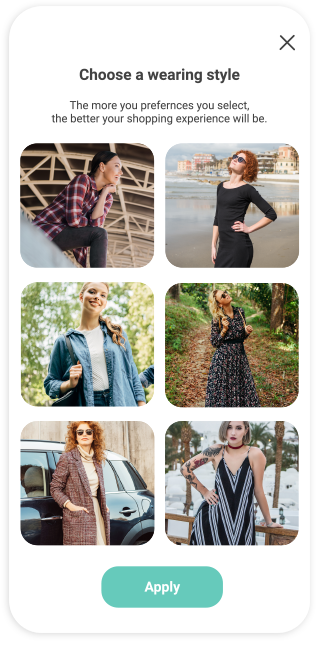

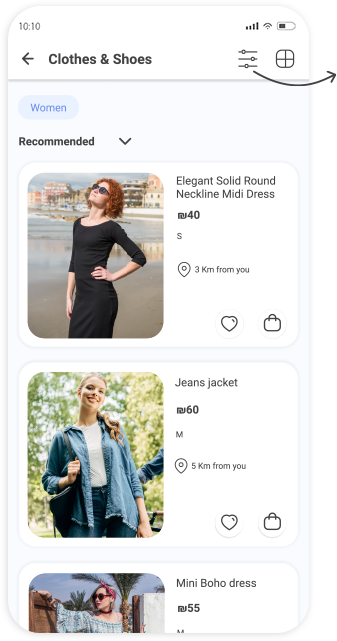
Results Page
The results page has the most relevant items after initial filtering. It is possible to choose a more specific filter like price range, item condition (used, just like new, new) and delivery options. Filtering tags that were chosen are shown at the top of the page.
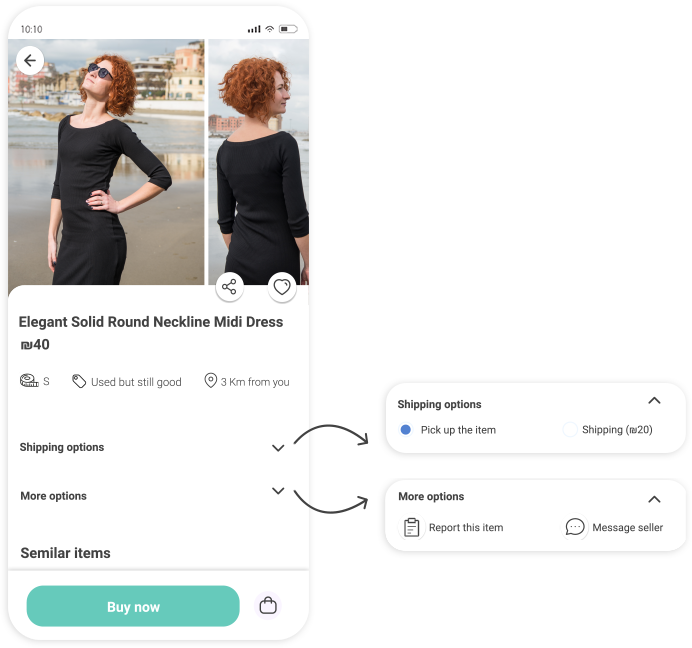
Item Page
On this page, the user can find the main details about the reward. The information is distributed with relevance to price, item condition and distributor location (distance from buyer). Also, the user can browse shipment options, look at similar items and contact the seller if there is a need.
Payment Proccess
The checkout page has a variety of payment methods that the supporter can use in order to transfer the funds.
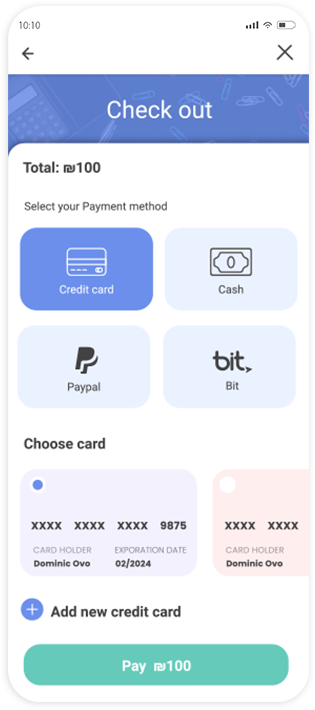
On the summary page, the user will find a summary of the chosen items and the selected supported projects.
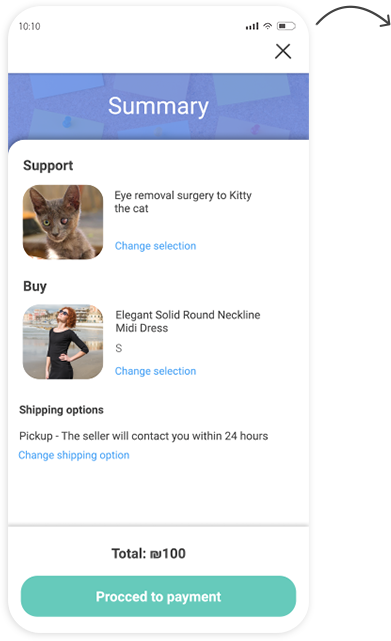
The user has the ability to choose the amount of funds on the payment page. The minimum amount will be at least the price tag of the goods.
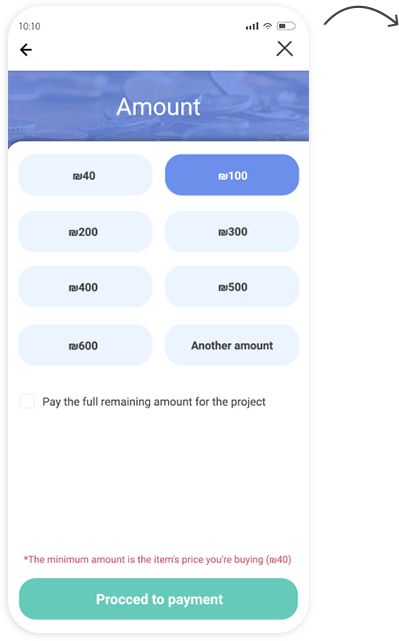
?What's Next
Creating a website – It may be possible that some people will prefer a website over an app. When the app will have many users that sell their items, it will allow the addition of more precise filtering for searching. For example, filtering of clothes: colors, fabric, brands etc. In the future, it should be considered to approach a wider audience, adding more social activities to support.
See more of my work:
Signalzz – Website
Achievement Center – Redesign project, Desktop app